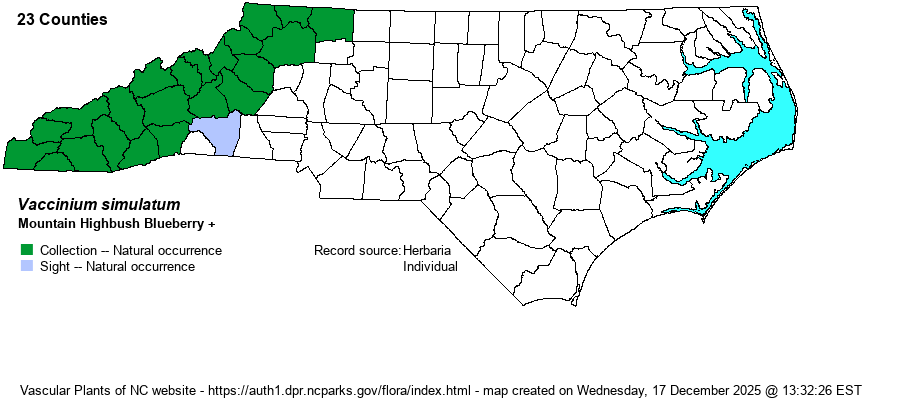| Section 6 » Order Ericales » Family Ericaceae |
Show/Hide Synonym
| taxonName | relationship | relatedTaxonName | relatedTaxonRefText | relComments |
|---|
|
|
|
|
|
| Vaccinium simulatum | < | Vaccinium corymbosum | Gleason and Cronquist (1991) | | | Vaccinium simulatum | < | Vaccinium corymbosum | Flora of North America (1993b, 1997, 2000, 2002a, 2002b, 2003a, 2004b, 2005, 2006a, 2006b, 2006c, 2007a, 2009, 2010) | | | Vaccinium simulatum | < | Vaccinium corymbosum | Stevens et al. in Kubitzki (2004). Key based in part on Uttal (1987). | | | Vaccinium simulatum | < | Vaccinium corymbosum | | | | Vaccinium simulatum | < | Vaccinium corymbosum | Wofford (1989) | | | Vaccinium simulatum | < | Vaccinium corymbosum | Stevens et al. in Kubitzki (2004). Key based in part on Uttal (1987). | | | Vaccinium simulatum | = | Vaccinium constablaei | Gleason (1952) | , misapplied | | Vaccinium simulatum | = | Vaccinium constablaei | Radford, Ahles, and Bell (1968) | , misapplied | | Vaccinium simulatum | = | Cyanococcus simulatus | Small (1933, 1938) | | | Source: Weakley's Flora |
|
| Author | Small | |
| Distribution | Throughout the Mountains, and sparingly into the western Piedmont, at higher elevations there. Seemingly most of what was formerly named as V. constablaei is now this species, but Weakley (2024) states: "The name V. constablaei has been misapplied to this species, as by RAB; see V. corymbosum for a discussion of the correct application of V. constablaei. There is controversy as to whether V. constablaei and V. simulatum are actually the same taxon. Vaccinium constablei is a hexaploid species, 2x = 72 (Redpath et al. 2022)".
This is a southern Appalachian endemic, ranging north only to southwestern VA and southern OH, and south only to extreme northern GA and northeastern AL.
| |
| Abundance | Fairly common to common in the Mountains, but rare in the Piedmont. | |
| Habitat | Unlike most other “highbush blueberries”, such as the closely related V. corymbosum, this species is essentially limited to upland habitats, favoring heath balds, upper slopes and ridges of hardwood forests, and spruce-fir forests. It is found mainly at higher elevations, mostly over 3500 feet. | |
| Phenology | Blooms with the emergence of leaves, from late April to early June; fruits in July and August. | |
| Identification | This is a medium-sized, deciduous shrub that grows to about 5-10 feet tall. Thankfully, its leaves are a bit different from most other blueberries, in that they are clearly lanceolate to narrowly ovate and have a long-tapered/acuminate tip. The leaves, which grow to about 2-2.5 inches long, are also sharply serrulate (not obvious at any distance). Also, its flowers are rather small (only 5-7 mm long) and can be somewhat pink to rosy, unlike other blueberries with larger or whiter flowers. Though it can be reasonably numerous at shrub balds and high elevation forests, this species could be easily overlooked among the many other species of ericaceous plants. | |
| Taxonomic Comments | As with several other Vacciniums, the scientific name has been changed in recent years, from V. constablaei to V. simulatum. According to Weakley (2018), the name V. constablaei was incorrectly applied to this species, when in reality V. simulatum was included within V. corymbosum for many decades. Some references still retain this taxon (simulatum/constablaei) within V. corymbosum, a very confusing and incorrect situation.
| |
| Other Common Name(s) | Upland Highbush Blueberry (probably a better common name than Mountain Highbush Blueberry) | |
| State Rank | S4 | |
| Global Rank | G5 | |
| State Status | | |
| US Status | | |
| USACE-agcp | | |
| USACE-emp | FACU link |

